A Low-Profile and High-isolated MIMO Antenna for 5G Mobile Terminal
Abstract
1. Introduction
2. Antenna Design
2.1. MIMO Antenna Array Structure
2.2. Antenna Element Design
3. Results and Discussion of the MIMO Antenna Array
3.1. S-parameters
3.2. Radiation Performances
3.3. MIMO Performances
3.4. Parametric Study
4. Conclusions
Author Contributions
Funding
Conflicts of Interest
References
- Foschini, G.; Gans, M. On Limits of Wireless Communications in a Fading Environment when Using Multiple Antennas. Wirel. Pers. Commun. 1998, 6, 311–335. [Google Scholar] [CrossRef]
- Jensen, M.; Wallace, J. A Review of Antennas and Propagation for MIMO Wireless Communications. IEEE Trans. Antennas Propag. 2004, 52, 2810–2824. [Google Scholar] [CrossRef]
- Jha, K.R.; Sharma, S.K. Combination of MIMO Antennas for Handheld Devices [Wireless Corner]. IEEE Antennas Propag. Mag. 2018, 60, 118–131. [Google Scholar] [CrossRef]
- Li, Y.; Zhang, Z.; Zheng, J.; Feng, Z. Compact Heptaband Reconfigurable Loop Antenna for Mobile Handset. IEEE Antennas Wirel. Propag. Lett. 2011, 10, 1162–1165. [Google Scholar] [CrossRef]
- Li, G.; Zhai, H.; Ma, Z.; Liang, C.; Yu, R.; Liu, S. Isolation-Improved Dual-Band MIMO Antenna Array for LTE/WiMAX Mobile Terminals. IEEE Antennas Wirel. Propag. Lett. 2014, 13, 1128–1131. [Google Scholar]
- Wong, K.-L.; Lin, P.-W.; Hsu, H.-J. Decoupled WWAN/LTE antennas with an isolation ring strip embedded therebetween for smartphone application. Microw. Opt. Technol. Lett. 2013, 55, 1470–1476. [Google Scholar] [CrossRef]
- Zhao, X.; Yeo, S.P.; Ong, L.C. Decoupling of Inverted-F Antennas with High-Order Modes of Ground Plane for 5G Mobile MIMO Platform. IEEE Trans. Antennas Propag. 2018, 66, 4485–4495. [Google Scholar] [CrossRef]
- Liu, D.Q.; Luo, H.J.; Zhang, M.; Wen, H.L.; Wang, B.; Wang, J. An Extremely Low-Profile Wideband MIMO Antenna for 5G Smartphones. IEEE Trans. Antennas Propag. 2019, 67, 5772–5780. [Google Scholar] [CrossRef]
- Chen, S.-C.; Chiang, C.-W.; Hsu, C.-I.G. Compact Four-Element MIMO Antenna System for 5G Laptops. IEEE Access 2019, 7, 186056–186064. [Google Scholar] [CrossRef]
- Deng, C.; Liu, D.; Lv, X. Tightly Arranged Four-Element MIMO Antennas for 5G Mobile Terminals. IEEE Trans. Antennas Propag. 2019, 67, 6353–6361. [Google Scholar] [CrossRef]
- Fernandez, S.C.; Sharma, S.K. Multiband Printed Meandered Loop Antennas with MIMO Implementations for Wireless Routers. IEEE Antennas Wirel. Propag. Lett. 2013, 12, 96–99. [Google Scholar] [CrossRef]
- Wong, K.-L.; Tsai, C.-Y.; Lu, J.-Y. Two Asymmetrically Mirrored Gap-Coupled Loop Antennas as a Compact Building Block for Eight-Antenna MIMO Array in the Future Smartphone. IEEE Trans. Antennas Propag. 2017, 65, 1765–1778. [Google Scholar] [CrossRef]
- Li, M.-Y.; Xu, Z.-Q.; Ban, Y.-L.; Sim, C.-Y.-D.; Yu, Z.-F. Eight-port orthogonally dual-polarised MIMO antennas using loop structures for 5G smartphone. IET Microw. Antennas Propag. 2017, 11, 1810–1816. [Google Scholar] [CrossRef]
- Jiang, W.; Liu, B.; Cui, Y.; Hu, W. High-Isolation Eight-Element MIMO Array for 5G Smartphone Applications. IEEE Access 2019, 7, 34104–34112. [Google Scholar] [CrossRef]
- Wong, K.-L.; Lu, J. 3.6-GHz 10-antenna array for mimo operation in the smartphone. Microw. Opt. Technol. Lett. 2015, 57, 1699–1704. [Google Scholar] [CrossRef]
- Cai, Q.; Li, Y.; Zhang, X.; Shen, W. Wideband MIMO Antenna Array Covering 3.3–7.1 GHz for 5G Metal-Rimmed Smartphone Applications. IEEE Access 2019, 7, 142070–142084. [Google Scholar] [CrossRef]
- Abdullah, M.; Kiani, S.H.; Iqbal, A. Eight Element Multiple-Input Multiple-Output (MIMO) Antenna for 5G Mobile Applications. IEEE Access 2019, 7, 134488–134495. [Google Scholar] [CrossRef]
- Chang, L.; Yu, Y.; Wei, K.; Wang, H. Orthogonally-Polarized Dual Antenna Pair with High Isolation and Balanced High Performance for 5G MIMO Smartphone. IEEE Trans. Antennas Propag. 2020, 1. [Google Scholar] [CrossRef]
- Wong, K.-L.; Lu, J.-Y.; Chen, L.-Y.; Li, W.-Y.; Ban, Y.-L. 8-antenna and 16-antenna arrays using the quad-antenna linear array as a building block for the 3.5-GHz LTE MIMO operation in the smartphone. Microw. Opt. Technol. Lett. 2015, 58, 174–181. [Google Scholar] [CrossRef]
- Guo, J.; Cui, L.; Li, C.; Sun, B. Side-Edge Frame Printed Eight-Port Dual-Band Antenna Array for 5G Smartphone Applications. IEEE Trans. Antennas Propag. 2018, 66, 7412–7417. [Google Scholar] [CrossRef]
- Li, Z.; Du, Z.; Takahashi, M.; Saito, K.; Ito, K. Reducing Mutual Coupling of MIMO Antennas with Parasitic Elements for Mobile Terminals. IEEE Trans. Antennas Propag. 2011, 60, 473–481. [Google Scholar] [CrossRef]
- Xu, H.; Zhou, H.; Gao, S.; Wang, H.; Cheng, Y.J. Multimode Decoupling Technique With Independent Tuning Characteristic for Mobile Terminals. IEEE Trans. Antennas Propag. 2017, 65, 6739–6751. [Google Scholar] [CrossRef]
- Zhou, X.; Quan, X.; Li, R. A Dual-Broadband MIMO Antenna System for GSM/UMTS/LTE and WLAN Handsets. IEEE Antennas Wirel. Propag. Lett. 2012, 11, 551–554. [Google Scholar] [CrossRef]
- Ghalib, A.; Sharawi, M.S. TCM Analysis of Defected Ground Structures for MIMO Antenna Designs in Mobile Terminals. IEEE Access 2017, 5, 19680–19692. [Google Scholar] [CrossRef]
- Li, M.-Y.; Ban, Y.-L.; Xu, Z.-Q.; Wu, G.; Sim, C.-Y.-D.; Kang, K.; Yu, Z.-F. Eight-Port Orthogonally Dual-Polarized Antenna Array for 5G Smartphone Applications. IEEE Trans. Antennas Propag. 2016, 64, 3820–3830. [Google Scholar] [CrossRef]
- Li, M.-Y.; Ban, Y.-L.; Xu, Z.; Guo, J.; Yu, Z.-F. Tri-Polarized 12-Antenna MIMO Array for Future 5G Smartphone Applications. IEEE Access 2017, 6, 6160–6170. [Google Scholar] [CrossRef]
- Zhao, A.; Ren, Z. Multiple-input and multiple-output antenna system with self-isolated antenna element for fifth-generation mobile terminals. Microw. Opt. Technol. Lett. 2018, 61, 20–27. [Google Scholar] [CrossRef]
- Zhao, A.; Ren, Z. Size Reduction of Self-Isolated MIMO Antenna System for 5G Mobile Phone Applications. IEEE Antennas Wirel. Propag. Lett. 2018, 18, 152–156. [Google Scholar] [CrossRef]
- Ren, Z.; Zhao, A. Dual-Band MIMO Antenna with Compact Self-Decoupled Antenna Pairs for 5G Mobile Applications. IEEE Access 2019, 7, 82288–82296. [Google Scholar] [CrossRef]
- Zhang, X.; Li, Y.; Wang, W.; Shen, W. Ultra-Wideband 8-Port MIMO Antenna Array for 5G Metal-Frame Smartphones. IEEE Access 2019, 7, 72273–72282. [Google Scholar] [CrossRef]
- Huang, D.; Du, Z.; Wang, Y. A Quad-Antenna System for 4G/5G/GPS Metal Frame Mobile Phones. IEEE Antennas Wirel. Propag. Lett. 2019, 18, 1586–1590. [Google Scholar] [CrossRef]
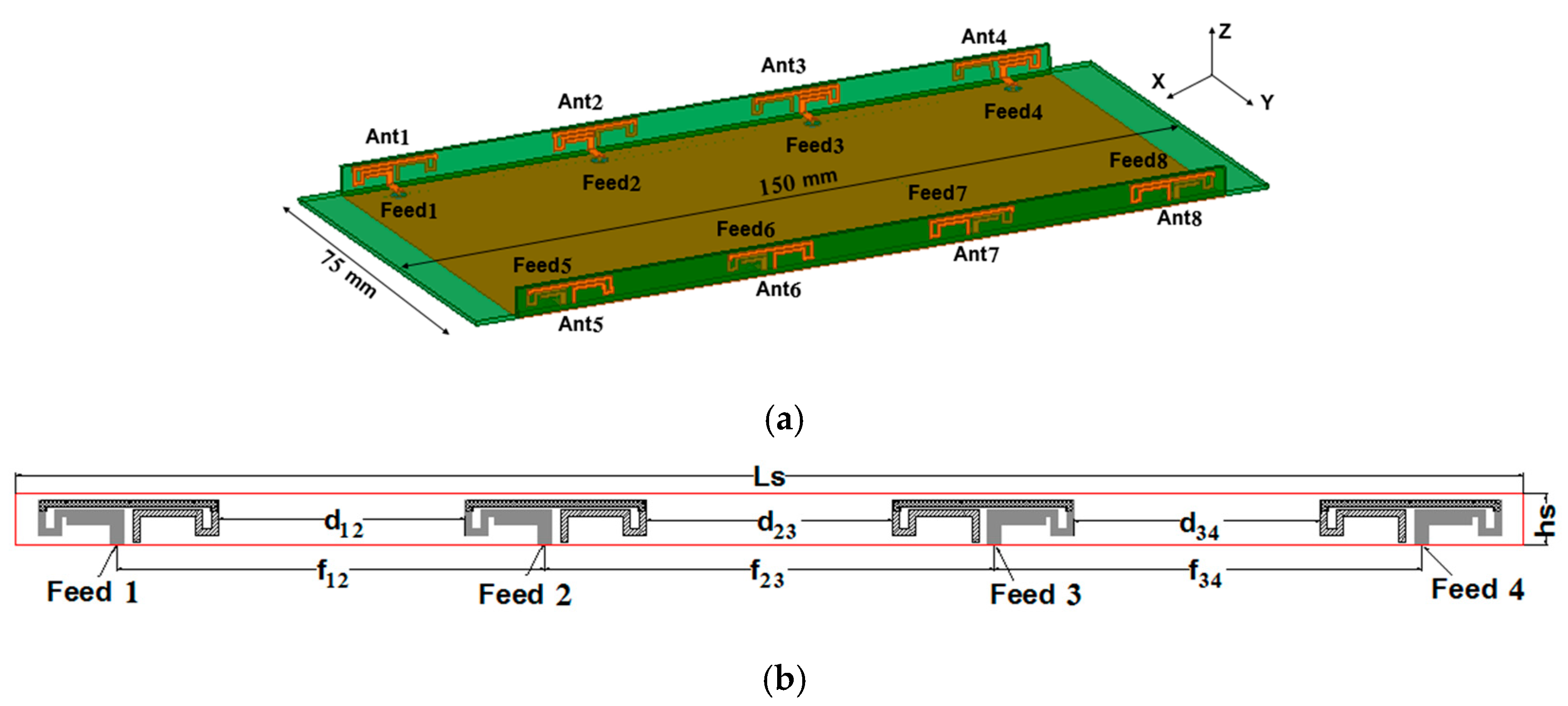


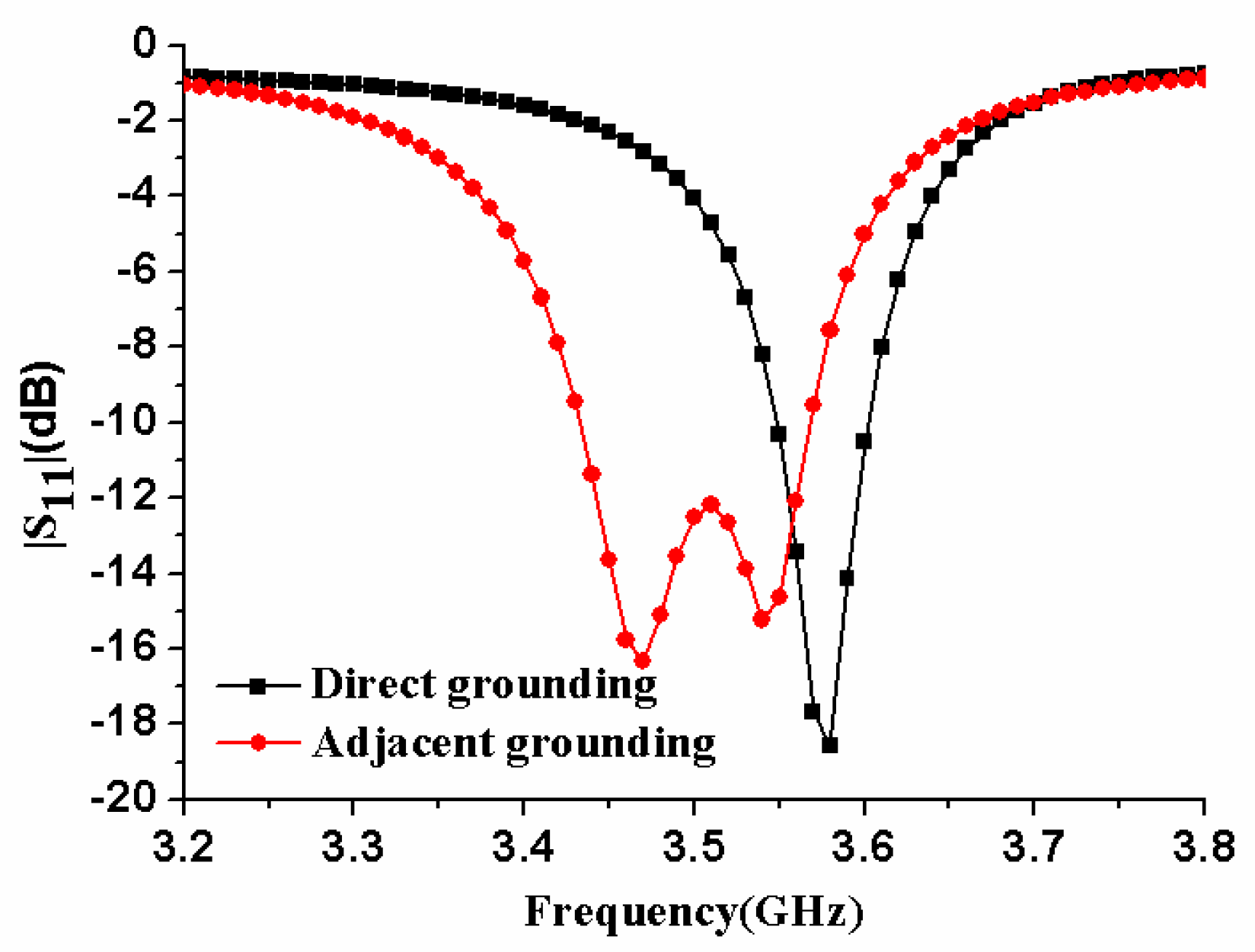
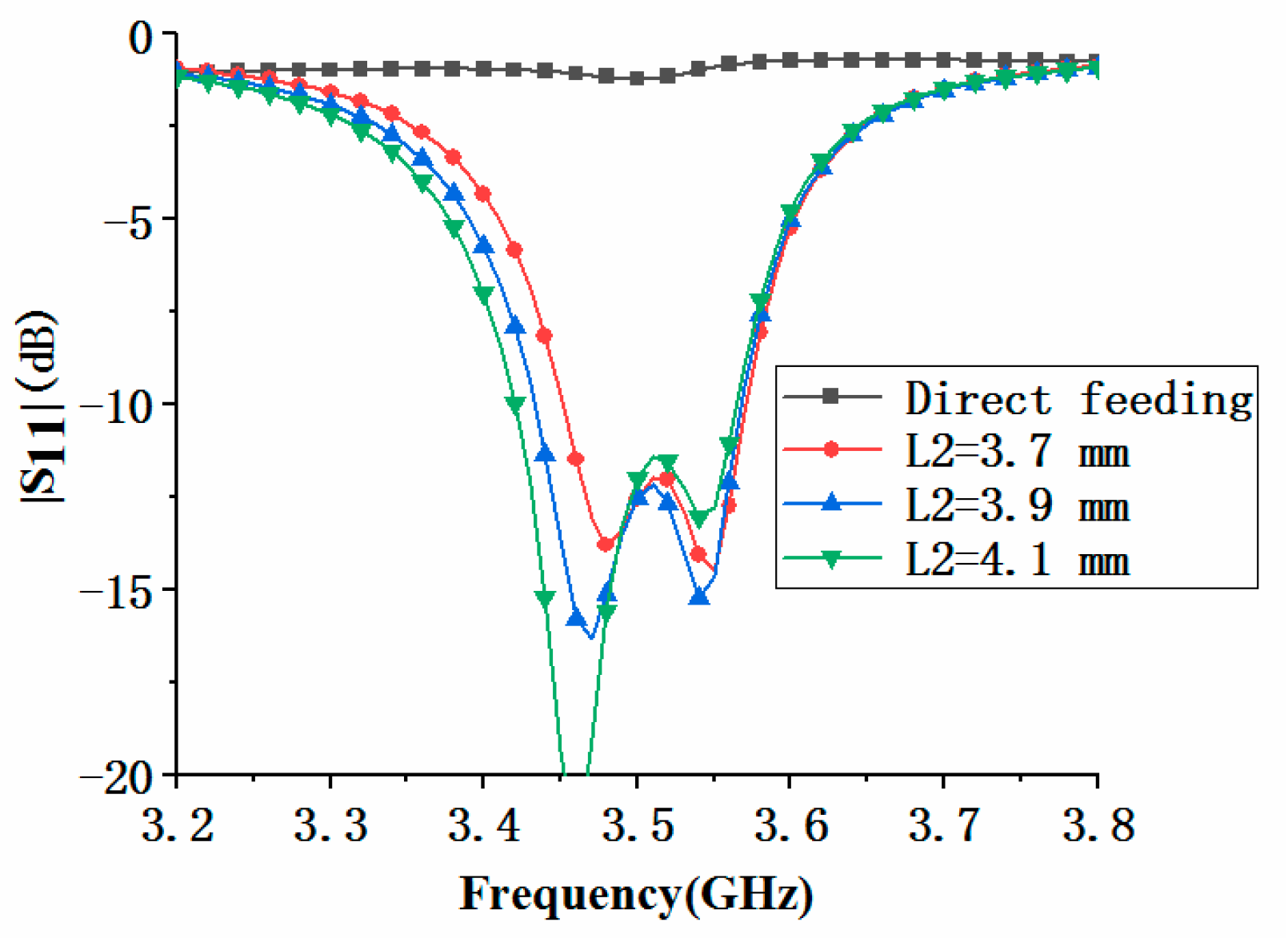

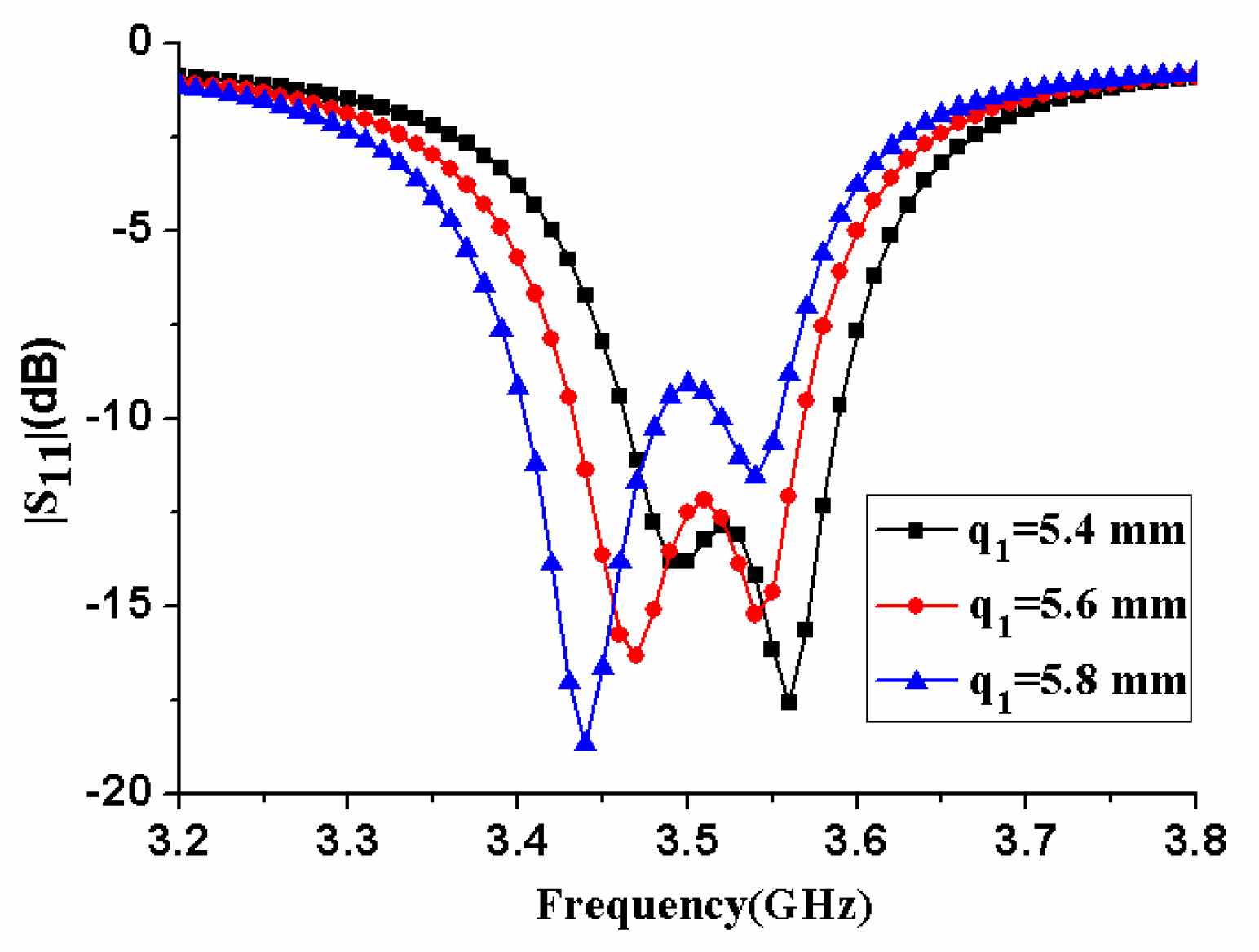








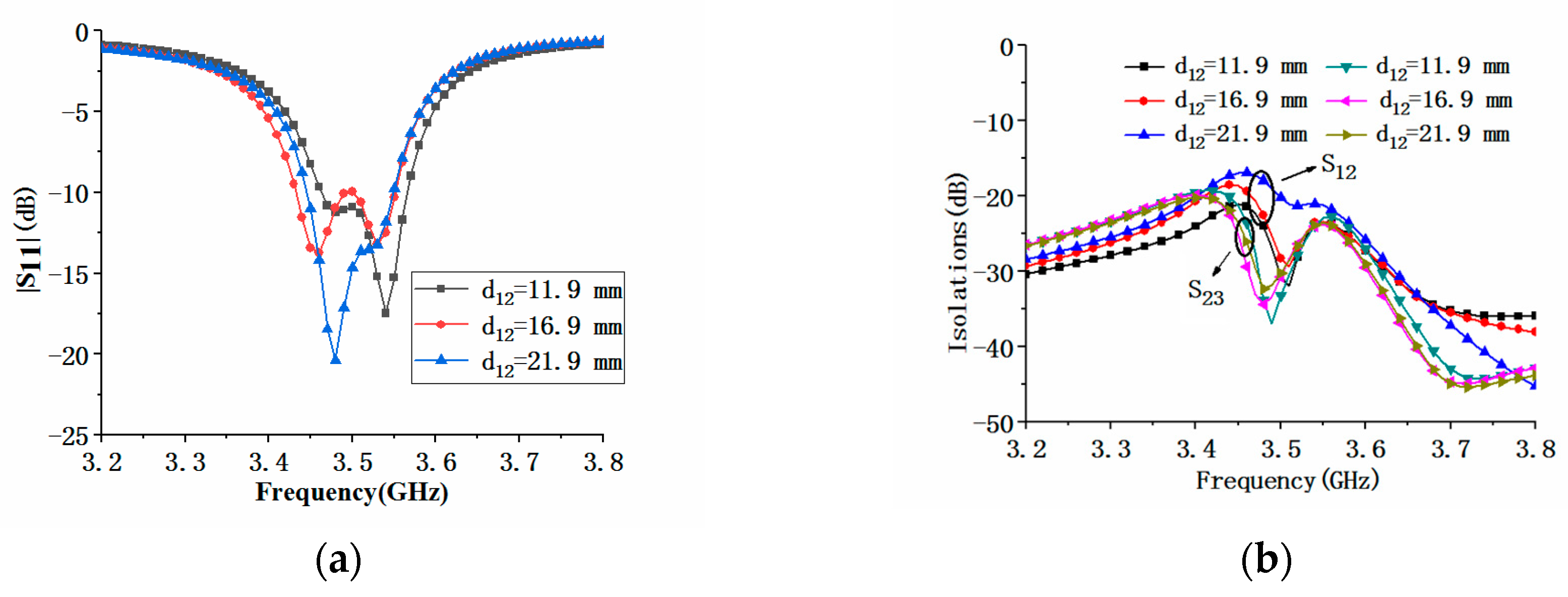

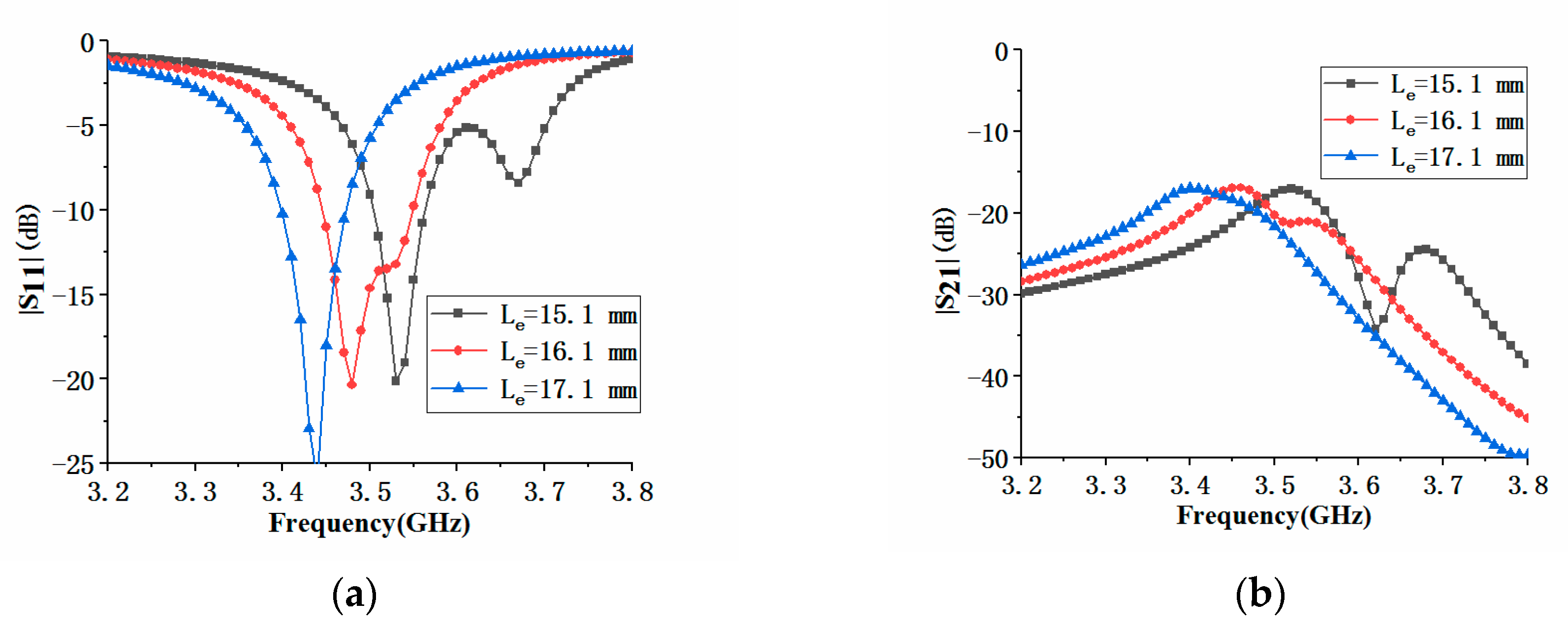

| Ref. | Size (mm3) | −6 dB-BW (MHz) | Isolation (dB) | Efficient (%) |
|---|---|---|---|---|
| Ref. [27] | 150 × 75 × 7.0 | 3350–3720 | −20 | 60–75 |
| Ref. [28] | 150 × 75 × 6.8 | 3340–3660 | −19 | 50–69 |
| Ref. [29] | 150 × 75 × 7.0 | 3350–3550 | −17 | 45–65 |
| Proposed | 150 × 75 × 5.3 | 3400–3660 | −20 | 33–47 |
© 2020 by the authors. Licensee MDPI, Basel, Switzerland. This article is an open access article distributed under the terms and conditions of the Creative Commons Attribution (CC BY) license (http://creativecommons.org/licenses/by/4.0/).
Share and Cite
Li, R.; Mo, Z.; Sun, H.; Sun, X.; Du, G. A Low-Profile and High-isolated MIMO Antenna for 5G Mobile Terminal. Micromachines 2020, 11, 360. https://doi.org/10.3390/mi11040360
Li R, Mo Z, Sun H, Sun X, Du G. A Low-Profile and High-isolated MIMO Antenna for 5G Mobile Terminal. Micromachines. 2020; 11(4):360. https://doi.org/10.3390/mi11040360
Chicago/Turabian StyleLi, Rongqiang, Zixu Mo, Haoran Sun, Xiaofeng Sun, and Guohong Du. 2020. "A Low-Profile and High-isolated MIMO Antenna for 5G Mobile Terminal" Micromachines 11, no. 4: 360. https://doi.org/10.3390/mi11040360
APA StyleLi, R., Mo, Z., Sun, H., Sun, X., & Du, G. (2020). A Low-Profile and High-isolated MIMO Antenna for 5G Mobile Terminal. Micromachines, 11(4), 360. https://doi.org/10.3390/mi11040360





